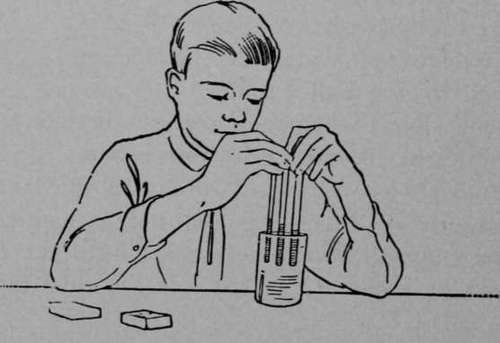Experiment 11. Magic
Description
This section is from the book "Experimental Glass Blowing For Boys", by Carleton J. Lynde. Also available from Amazon: Experimental Glass Blowing for Boys.
Experiment 11. Magic
You have always heard that water runs downhill, but you will now see it run uphill and remain there in a most magical manner.
Cut off 5-inch lengths of No. 6, No. 4, and No. 2 tubing, stand them side by side in a glass full of water (Fig. 19), and move them up and down in the water to wet the inside of the tubes.

Fig. 18. Air Through Tube

Fig. 19. Water Runs Uphill
Now look at the water level in each of the tubes. Is it above the level of the water in the glass, and is it higher the smaller the inside diameter of the tube, that is, is it higher in the No. 2 than in No. 4, and in No. 4 than in No. 6?
Now take the thin capillary tube which has the largest inside diameter, place one end in the glass of water, suck it full of water and blow it out. Now with one end in the glass of water notice quickly how the water rises inside the tube. Does it run uphill in a most magical manner (Fig. 20), and does it remain there ?
Repeat this with your other capillary tubes. Does the water run uphill in each, and does it rise higher the smaller the inside diameter of the tube?
The "why" of this is explained in Gilbert's "Experimental Mechanics" under "Capillarity."
Continue to:
